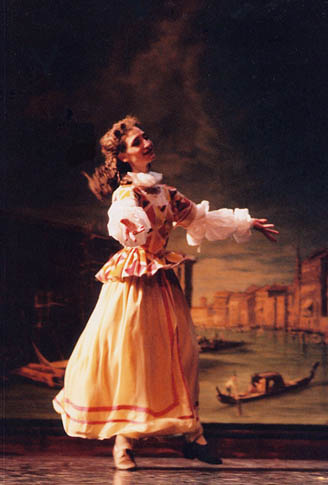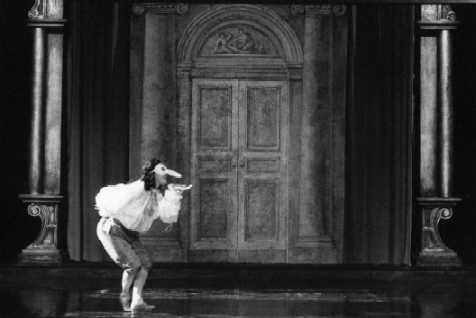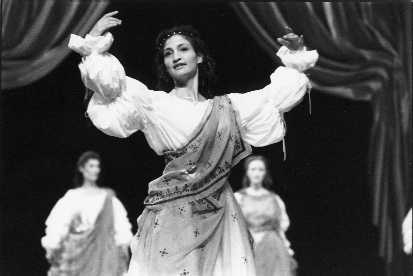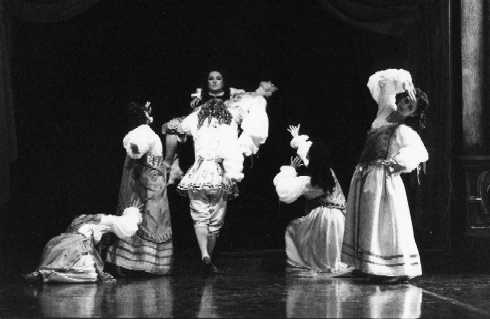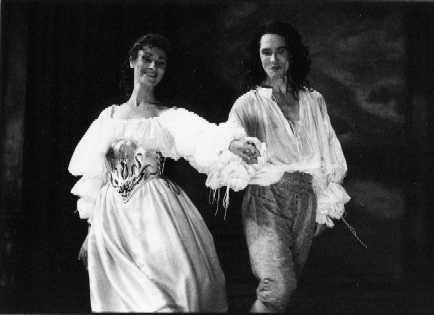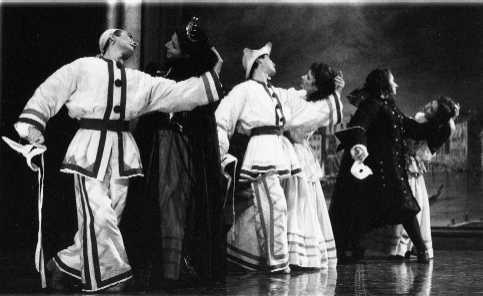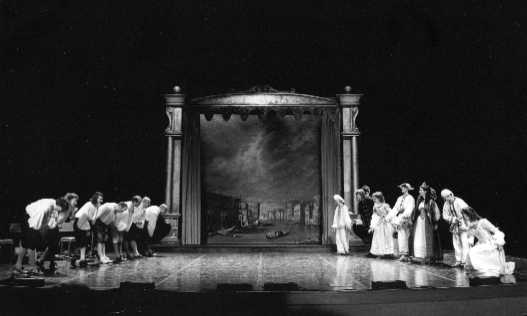
Home Page
L’Eventail
Exhibition Parcours Baroque
NEW
Le Ballet de l’Amour Malade
Saynètes des rues, des rivières et des bois
Prologue au Cabinet des Fées
Don Juan
Voyage en Europe
The Carnival
Les Caprices de la Danse
Ballet des Masques
Press Review
Links in Baroque Dance
L’EVENTAIL BAROQUE DANCE COMPANY
and
LES FOLIES FRANÇOISES
present
Ballet in 4 scenes for 7 dancers
Music by
| Campra | Les Fêtes Vénitiennes (highlights) |
| Purcell | Suite for orchestra from Deoclesian (highlights) |
| Rosenmüller | Sonata in E minor for two violins and continuo |
| Vivaldi | Concerto for luth in D minor RV 540, Trio in G minor RV 85 |
A creation by L’Eventail Baroque Dance Company
Coproduced by the
Festival de Sablé-sur-Sarthe
in residence at Espace Carpeaux in Courbevoie and the Centre Culturel de Sablé-sur-Sarthe
| Design and choreography | Marie-Geneviève Massé |
| Music conducted by | Patrick Cohën Akenin |
| Costumes | Olivier Bériot |
| Set |
Marie-Geneviève Massé and
Jean-Marie Abplanalp |
| Lighting | Véronique Guidevaux |
|
with
and 7 dancers from Length of the performance: 1 hour and 15 minutes without intermission |
|
The inspiration behind the desire to create “Voyage en Europe”
For some mysterious reason, we find ourselves deeply moved and touched by certain kinds of music. They awaken within us a sort of nostalgic memory, universal and dizzy, and at the same time comfort us with the gentleness of childhood memories.
We desire with all our hearts to share this miracle of emotion, vulnerable sensations, and intimate strength, to avoid being alone, and we do not dare.
Today, I dare, I take the step…to dance: I take the risk of sharing with you, the stirring music of Campra, Rosenmüller, Vivaldi, Purcell.
Like an illusionist, the music of each four composers makes to appear some characters who, like in a dream disappear about of each evocation.
Marie-Geneviève Massé
[Back to top of page.]
First Scene
France or the Rehearsal
“Les Fêtes vénitiennes” (1710) by André Campra (1660-1744)
Choreographed in 1710 by the Dancing Master Louis-Guillaume Pécour for the Fêtes Vénitiennes, many of the solos and duets therein have found their way into today’s repertoire.
With France leading the way in the art of dancing at the time, and with respect to the relevant spirit and aesthetics, it is thus indispensable that these choreographies be present in today’s programme of our voyage which begins in the new performance hall recently constructed by Louis XIV’s niece, Elizabeth Charlotte d’Orléans.
The Duchess herself being a dancer of high calibre, she and her husband, Duke Leopold the 1st, are preparing a surprise for their next “divertissement”, which they are planning to present at their court in Lorraine. At the moment, they are in the rehearsal hall, in the company of the finest Dance Masters, working on a small suite of dance excerpts from André Campra’s Fêtes Vénitiennes, created for the Academie Royale de Danse in Paris, and which became quite popular at the time.
As time permits, and in order to accompany them on stage, she has gathered around her the most renowned dancers in Paris and Europe. However, it is only their mutual passion for the dance which enables them it side-step the hindrances occasioned by a rigorous hierarchy, allowing the Prince or the Duchess to follow the lead of the minstrel.
Characters
Duchess Elisabeth Charlotte d’Orléans
Duke Léopold Ier de Lorraine
Mlle Prévost
Mlle Sallé
Louis Dupré
La Barbarina
Fossano
2nd Scene
Britain or the Tragedy
Suite from “Dioclesian” (1690) by Henry Purcell (1659-1695)
Having taken a ship to the English coast, in scene 2 we alight in London, the centre of creation of action ballets. It is here that we meet the innovative Marie Sallé, who having dared to forego the traditional dress, is draped in antique robes...
The theatre is being readied, the curtain is about to rise, hornpipe, paspe and chair dance will captivate us with an unusual impression of freedom, a je ne sais quoi of tradition, sentiment and drama absent in the usual stereotypes in France and Italy. The drama unfolds to the rhythm of the music. The slightest tune is led by Purcell’s incomparable capacity to render a theatrical touch each of his compositions.
Characters
The Young Lady
The Prince
The three Sisters
The two Companions
3rd Scene
Germany or the Memory
Sonata in E minor (1682) by Johann Rosenmüller (1619-1684)
The Sonata is a dialogue for three in which “one must never be able to tell which of the two leading voices is the dominating one”: a uniting dialogue between the two violins and the basso-continuo, answering each other in like form.
Dialogue also between the music and the dance, through theatrical expression and the different movements of the Sonata da camera, which could simply dances.
Dialogue again between cultures: a creation representing the art of the violin in Germany, this Sonata is replete with Italian elegance. A subtle alchemy which seems less surprising when we realise that Rosenmüller spent twenty years in Venice, where he composed for the Pieta l’Ospedale, Vivaldi’s stepping stone to fame, before returning to Lower Saxony.
It is in Wolfenbüttel Castle, home of the Duke of Brunswick, where the third step of your voyage takes place, not for the purposes of light conversation, but to evoke remembrances about the Sonata’s moving dialogue.
Characters
The Duke and the Duchess of Brunswick
The Lovers
The Guests
4th Scene
Italy or the Missing
Concerto in D minor and Trio in G minor by Antonio Vivaldi (1678-1741)
Be it for the exuberance of the bright movement or for the plaintive sound of the slow movement, a Vivaldi Concerto inevitably brings us to Venice. The city’s impetuous qualities are echoed in the Concerto’s form. A mirror of light and color, a spiritual and loving dialogue, Vivaldi transforms a purely musical play between musician and orchestra into a dramatic one.
Each Concerto is an iridescent tableau of a Guardi or a Tiepolo. Ephemeral pleasure, seduction, lyricism, and marvellous rhythmical impulses of the lute and violins answer to the enchantment, caprice and extravagance of the Venetian carnival.
Let us follow the knight Matteo Sylvani as he travels through this city where ‘no one goes nowhere without being masked’. We can no longer tell who is who, or else we find ourselves pretending to…
Characters
Three Punchinellos
The Princess
Knight Matteo Sylvani
Two Harlequin women
“
Passion baroque” Andrée Martin, Le Devoir, Feb. 19, 2001
Danser, Odile Cougoule, Oct. 2000
« La musique et la danse baroque célèbrent leurs noces à Sablé-sur-Sarthe » Le Monde, Aug. 31, 2000.
« L'Enventail de Marie-Geneviève Massé s’installe en résidence à Sablé » Le Monde, Aug. 31, 2000.
«
Le Gala de la Compagnie l'Eventail ou l’Âme de la Danse » Le Maine Libre, Aug. 25, 2000.
[Go to top of page.] [Version française.]
Number of visitors
Copyright © L’Eventail 2004

